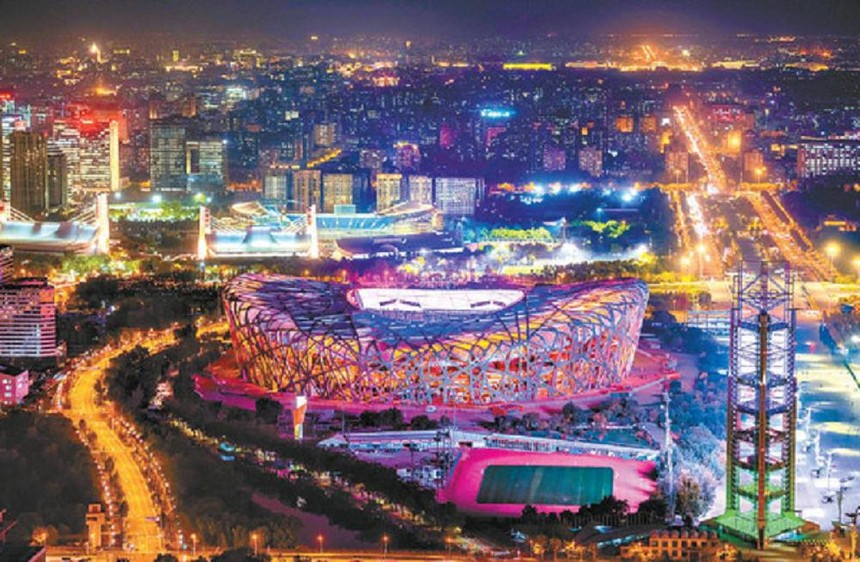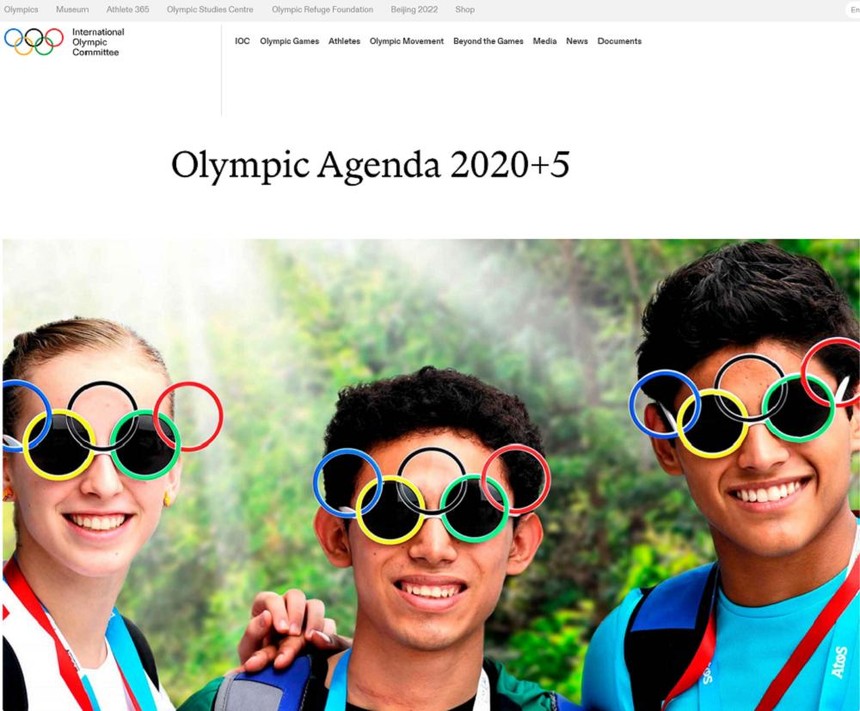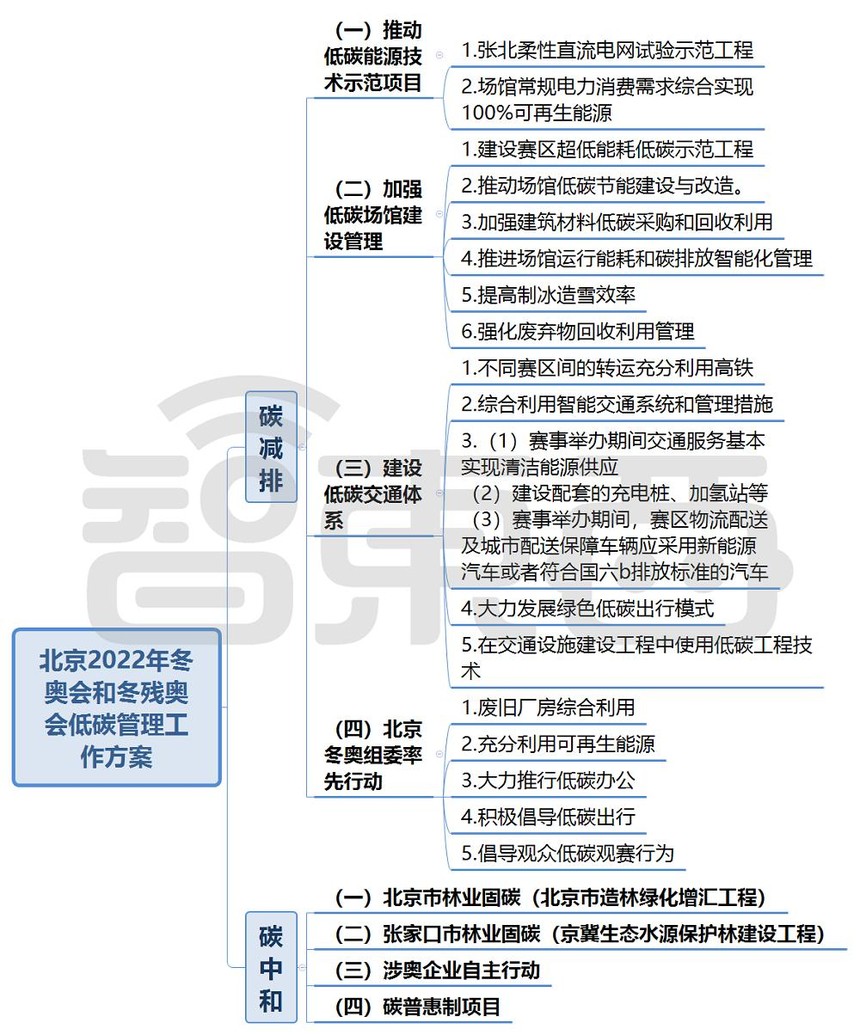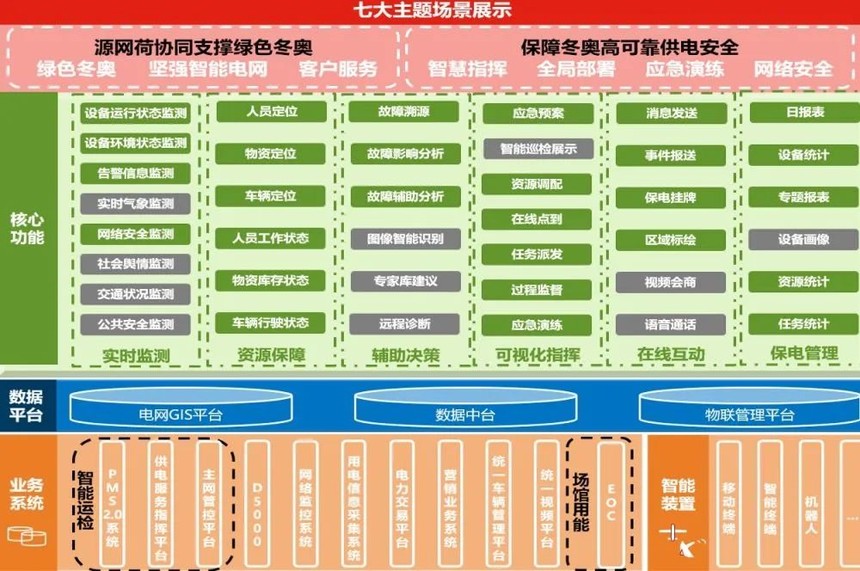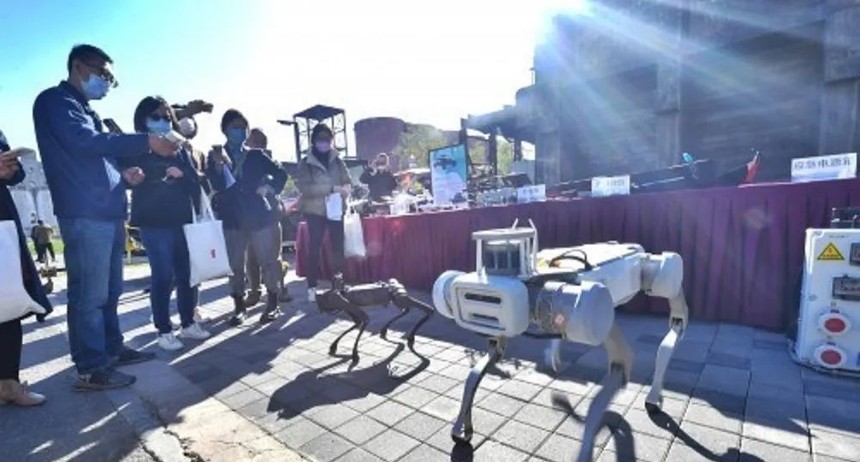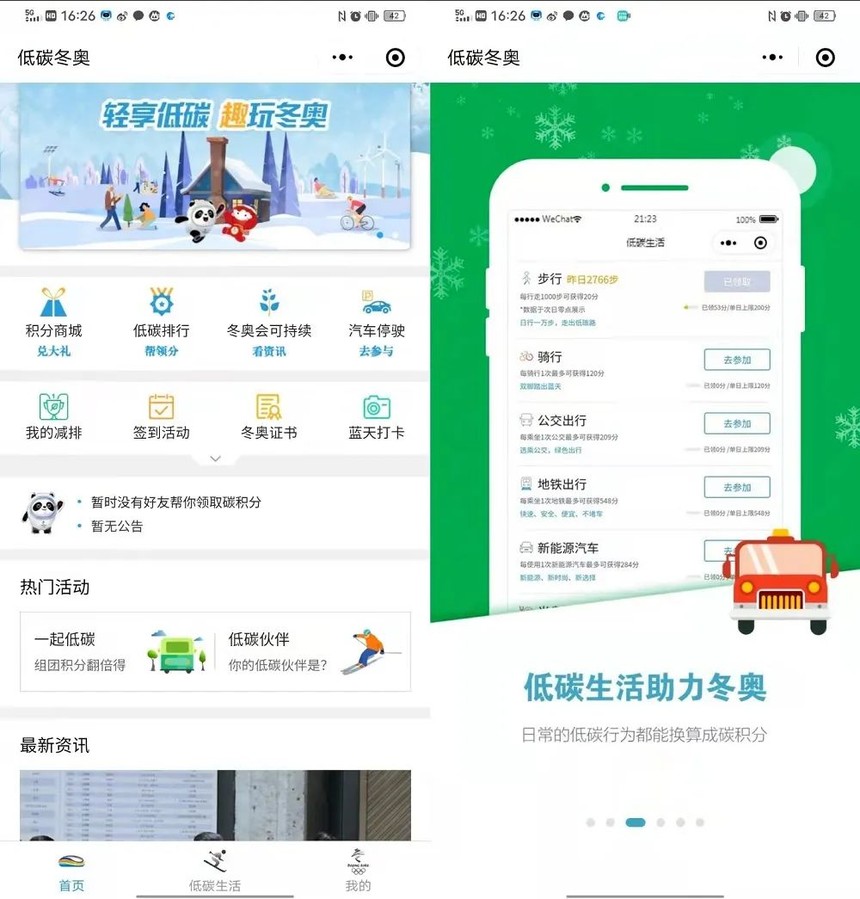|
Secrets of the first Zero-carbon Winter OlympicsBeijing is brightly lit at night, and the National Stadium, the Bird's Nest, is no exception. The Bird's Nest, which will host the opening and closing ceremonies of the Beijing Winter Olympics and Paralympics, was upgraded last month to include a landscape lighting system and many other facilities, incorporating technology, green and intelligent elements. Through operation mode control, the nest can achieve 30% energy saving effect.
▲ Bird's Nest (source: Beijing Daily) The transformation of the Bird's Nest is one of the key measures to achieve low-carbon Winter Olympics. For the first time in history, all venues will be powered by renewable energy. Beijing has made a solemn promise to the world that it will achieve carbon neutrality. According to the 14th Five-Year Plan released in March, an action plan for peaking carbon emissions by 2030 was formulated, anchoring efforts to achieve carbon neutrality by 2060. The Winter Olympics' commitment to carbon neutrality is an important opportunity to deliver green and low-carbon ideas to society. How will the Beijing Winter Olympics become the first truly carbon-neutral Olympic event? As a major event attracting worldwide attention, the Beijing Winter Olympic Games will start from four aspects of energy, construction, transportation and carbon sequestration, and achieve low-carbon hosting through the application of a variety of cutting-edge technologies such as artificial intelligence and 5G. 01. 18 carbon emission reduction measures from four aspects Beijing Winter Olympics carbon neutral to do so Due to global warming, various extreme meteorological events have become more and more frequent. Low carbon emission reduction has become an important global environmental issue, which is related to the future fate of mankind and the earth. As one of the largest sports activities in the world, the Construction of venues, competition and various operations and maintenance will consume a lot of resources and generate carbon emissions, especially for the Winter Olympics, where the snow and ice conversion work may produce more carbon emissions than the Summer Olympics. In the face of global climate issues and resource mobilization for the Olympic Games, the IOC has been encouraging and promoting a low-carbon, green and sustainable Olympic Games. In March 2021, the IOC issued a new reform roadmap, Olympic Agenda 2020+5, which contains 15 reform proposals, one of which is to promote a sustainable Olympic Games.
The previous Winter Olympics, such as the Vancouver Winter Olympics (2010), were carbon neutral in two aspects. First, renewable hydropower was used, buses and cars in the city were mostly powered by hydrogen, and public transportation was promoted. Second, through cooperation with the Green Energy Agency, low-carbon projects will be built around the world to offset part of carbon emissions. In addition, the Vancouver Games will use green buildings to reduce energy consumption. The Sochi Winter Olympics (2014) also had a special design, using transparent glass structure to save energy; In addition to adopting green buildings and clean energy, the 2018 Pyeongchang Winter Olympics also installed a greenhouse gas monitoring system and released a carbon management report. However, these Games are prone to dilapidated venues, some of the energy is non-renewable, and there is no large-scale use of smart technology. Compared with previous Games, Beijing will deliver an even better result: carbon neutrality. As early as 2019, the Beijing Organizing Committee for the Winter Olympic Games formulated the Low-carbon Management Plan for the Beijing 2022 Winter Olympic and Paralympic Games (hereinafter referred to as the Low-carbon Management Plan for the Winter Olympic Games), in order to fulfill the commitment made when bidding for the Winter Olympic Games, promote the construction of China's ecological civilization, and play an innovative role in addressing climate change. The low-carbon management plan for the Winter Olympics includes four low-carbon targets: low-carbon energy, low-carbon venues, low-carbon transportation and low-carbon standards. It also identifies four major 18 carbon emission reduction measures, four carbon neutralization measures and four safeguard measures.
▲ Key points of the Low-carbon Management Plan for Beijing 2022 Winter Olympic and Paralympic Games Under the guidance of relevant government departments, the Beijing Organizing Committee for the Winter Olympics is actively promoting the implementation of carbon emission reduction and carbon compensation measures together with enterprises and units involved in the Olympics. In May this year, the Beijing Winter Olympics Carbon neutral proposal demonstration meeting was held to continuously implement the carbon neutral goal of the Winter Olympics. Last week, Juan Antonio Samaranch Jr., chairman of the INTERNATIONAL Olympic Committee's Beijing Winter Games Coordination Commission, said at an online press conference on technical preparations for the Games that the Beijing Winter Olympics are on track to be carbon neutral. To achieve carbon neutrality in the Winter Olympics is not only to fulfill the promise of the Bid, but also to show China's green and low-carbon practice at home and abroad. It can also encourage more institutions and individuals to develop green and low-carbon, but also promote the transformation of energy consumption structure in Beijing, Hebei and other places, and stimulate the use of more green and low-carbon products. The realization of low-carbon energy, low-carbon venues and low-carbon transportation involves many industries. The realization of carbon neutrality in the Beijing Winter Olympic Games will also promote the research and development of green and low-carbon products and technological innovation in various fields, which is a good opportunity for the popularization of intelligent carbon emission management schemes. 02. Green energy and Green Venues: "Smart Brains" visually manage energy supply and use What is worth mentioning is the construction of zhangbei flexible DC power grid and other low-carbon energy demonstration projects, realizing that for the first time in the history of the Olympic Games, all venues are fully covered by the city's green power grid. This is one of the biggest highlights of the Beijing Winter Olympics. Ensuring a smooth supply of green energy is a top priority, as is making energy use more efficient, and these needs can only be met by "smart brains" built by the relevant authorities using artificial intelligence and other technologies. 1. Beijing Winter Olympics Power operation guarantee command platform to ensure green electricity supply Venues such as the Bird's Nest and water Cube require electricity, as do devices such as smart thermometers and service robots. For the first time in Olympic history, all 25 venues in the three sports areas will be powered by clean energy. To ensure green power supply, zhangbei flexible DC power grid test and demonstration project, Beijing Winter Olympics Power Operation Support Command Platform (EOC) and other projects can not be ensured without the support of the Beijing Winter Olympics Power Operation Support Command Platform (EOC), which is like the smart brain to ensure green power supply for all venues.
▲ Beijing Winter Olympics Power Operation Guarantee Command Platform (source: CLP Media Energy Big Data) The power operation command platform for the Beijing Winter Olympics can monitor the power situation in venues in real-time and panoramic mode by using technologies such as digital twin, knowledge map and intelligent voice. The platform is connected to 29 business systems of Beijing Power of State Grid Corporation of China, involving 187 index data such as green power, materials and security. The Beijing Winter Olympics Power Operation Support Command Platform is responsible for the overall situation, while the Zhangjiakou Winter Olympics Support Command Center is mainly responsible for ensuring the local green power supply. State grid company hebei north power through the development of six core functions, build seven themes, blends together the 13 sets of system data create zhangjiakou commanding platform for the games, with 5 g, wisdom, such as artificial intelligence technology, real-time perception associated equipment running status and internal and external environment, the relevant staff overview the global, quick decisions.
▲ Winter Olympics Power Supply Command Platform Functional architecture (source: Xinhua) In addition, The State Grid Company Beijing Electric Power also uses hydrogen energy generators, power inspection robot dogs, anti-collision drones to strengthen the detection of hidden dangers in stadiums and other projects to ensure the operation of the power grid.
▲ Power inspection robot dog (source: Beijing News) 2. Energy control center makes energy consumption lower In addition to using renewable energy to reduce carbon emissions, the Beijing Winter Olympics will build energy control centers at 10 venues in Beijing and Yanqing. The energy control center monitors the use of electricity, gas, water, heat and other energy resources in the venue in real time, and uses big data, artificial intelligence and other technologies to complete visual management of building energy consumption and carbon emission monitoring, so as to reduce energy consumption. At the same time, the smart building operating system will be deployed in the venues, based on 5G and AI technologies, to achieve a comprehensive real-time situation awareness of the entire Winter Olympic village. Wisdom contained in the operating system of intelligent building construction carbon management platform, which can realize to single or multiple building multidimensional real-time online monitoring and accounting analysis, carbon assets credit management, guide the energy conservation and emissions reduction technology applications such as carbon emissions management functions, and according to the venue, meteorological data, etc., can predict building, can use optimization. In order to more directly demonstrate to the audience the realization of the carbon-neutral promise of the Green Winter Olympics, the Press Center of the Olympic Village has also built a green and smart energy exhibition center, which will display the entire process of green electricity production, transmission, consumption and energy conservation through smart technologies such as 5G and Internet +. 03. Green transportation: optimize traffic operation management system Improve fuel efficiency of transportation In addition to making the energy use of the venues more low-carbon, the transportation within the venues, as well as the transportation between the venues and the urban areas, will also need to be made greener.
1. Improve the urban public transport operation and scheduling system and encourage public transport Low-carbon transportation is also an important measure for the Beijing Winter Olympics to achieve carbon neutrality. Transportation services within the Olympic area will basically be provided with clean energy, and hydrogen fuel vehicles will be promoted.
Hydrogen vehicles (source: BoCOG) ETC will be installed on all transport service vehicles for the Beijing Winter Olympic Games to ensure fast passage. In addition to promoting the use of new energy vehicles, building a low-carbon transport system also includes encouraging the use of public transport and the application of intelligent traffic management systems, improving the fuel efficiency of transport and reducing the carbon emissions of transport. The relevant departments of Beijing and Zhangjiakou and the Beijing Organizing Committee for the Winter Olympic Games will strengthen the communication of transport information between the Winter Olympic Games and urban transport, improve the urban public transport operation and scheduling system, and improve the intelligent management level of the transport system. In addition, relevant departments will integrate traffic and weather information, improve the traffic information query system, through the use of dynamic traffic information release and guidance system and other technologies to provide traffic information services for the Winter Olympics visitors; Through the implementation of analysis and analysis of the flow of people and vehicles, strengthen the release of public transport, intercity transport, parking lots, charging piles and other transport facilities information.
Chongli Traffic Comprehensive Control Center (source: Hebei Daily) For example, Chongli Intelligent Traffic Comprehensive Control Center in Chongli District, Zhangjiakou City can perceive and judge the overall traffic situation through big data and other technologies to assist managers in timely traffic dredging and solving congestion problems. 2. Build the digital twin model of the venue to help the surrounding traffic management Smart, digital upgrades of venues will also help improve transport efficiency and reduce carbon emissions. As the national stadium, also has a twin system, the digital future twin system dynamically through digital collection and relevant equipment running situation, the surrounding road traffic situation, unicom, digital construction and urban traffic system based on artificial intelligence to form the optimal solution, change events in some urban poor inside venues around the traffic situation, improve vehicle traffic near the fuel efficiency. Advocate green travel, the whole people to participate in the Winter Olympics carbon neutral In addition to using smart transportation systems, providing more comprehensive and timely information on public transportation, and encouraging more people to go low-carbon, the Beijing Winter Olympics has also developed other ways for people to participate in carbon neutrality. The Beijing Organizing Committee for the Winter Olympics has launched a mini program called "Low-carbon Winter Olympics", which uses digital technology to record users' low-carbon behaviors in their daily lives and encourage and guide the public to participate in green and low-carbon life. For example, people can choose green home appliances by participating in green modes of transportation such as bus, subway and cycling, and choose green home appliances when buying home appliances. They can use low-carbon office methods such as online meetings and other low-carbon activities to obtain points and exchange them for low-carbon certificates and gifts.
▲ Low carbon Winter Olympics small procedures 04. Conclusion: Winter Olympics as carbon neutral sample The Beijing Winter Olympics is both a high-tech Winter Olympics and a carbon-neutral Winter Olympics, showcasing a number of low-carbon, green and smart Olympic scenes, which will not be without the help of cutting-edge intelligent technologies such as big data, artificial intelligence, 5G and digital twin. At the same time, the Beijing Winter Olympics is also a great opportunity to show how smart technology can play a role in carbon neutrality, such as building energy management, and provide a reference for other companies and institutions to promote carbon neutrality. |




